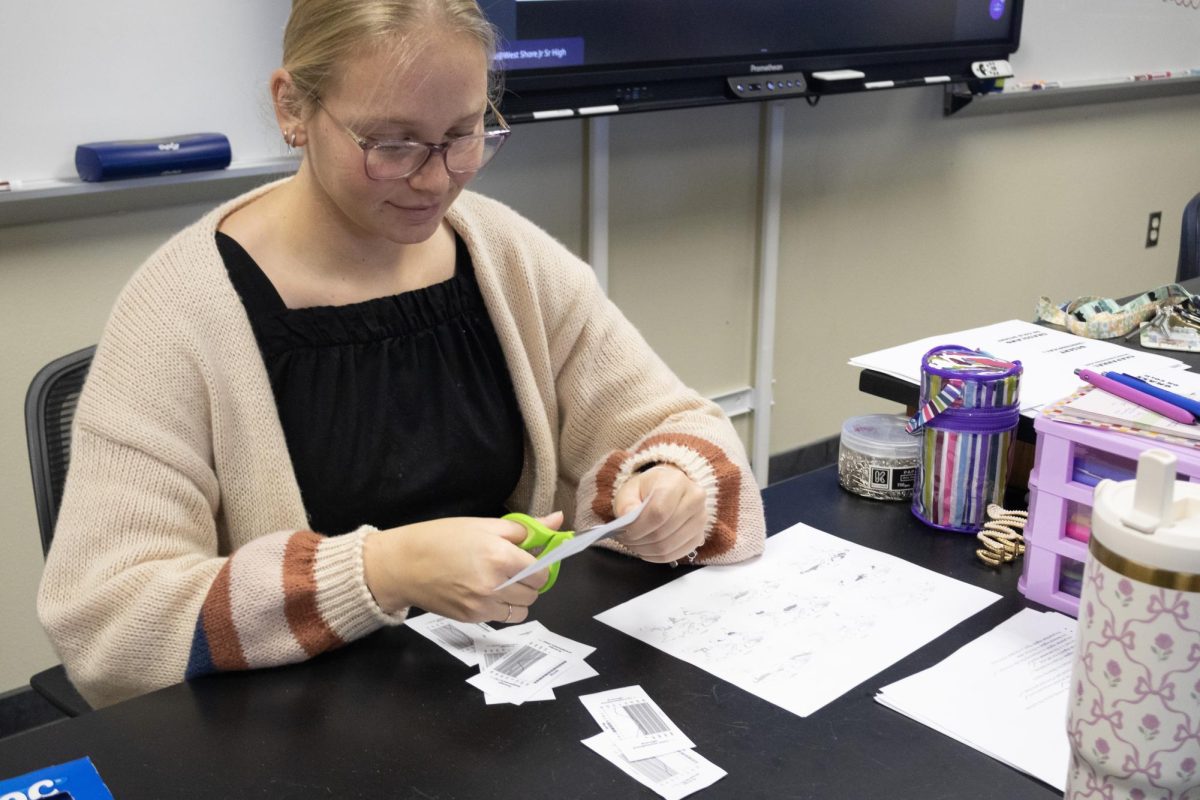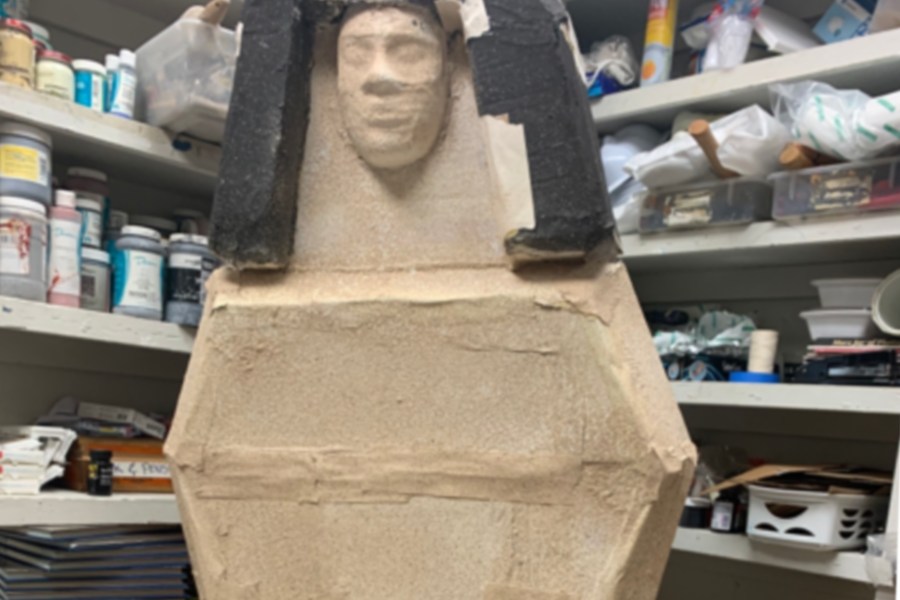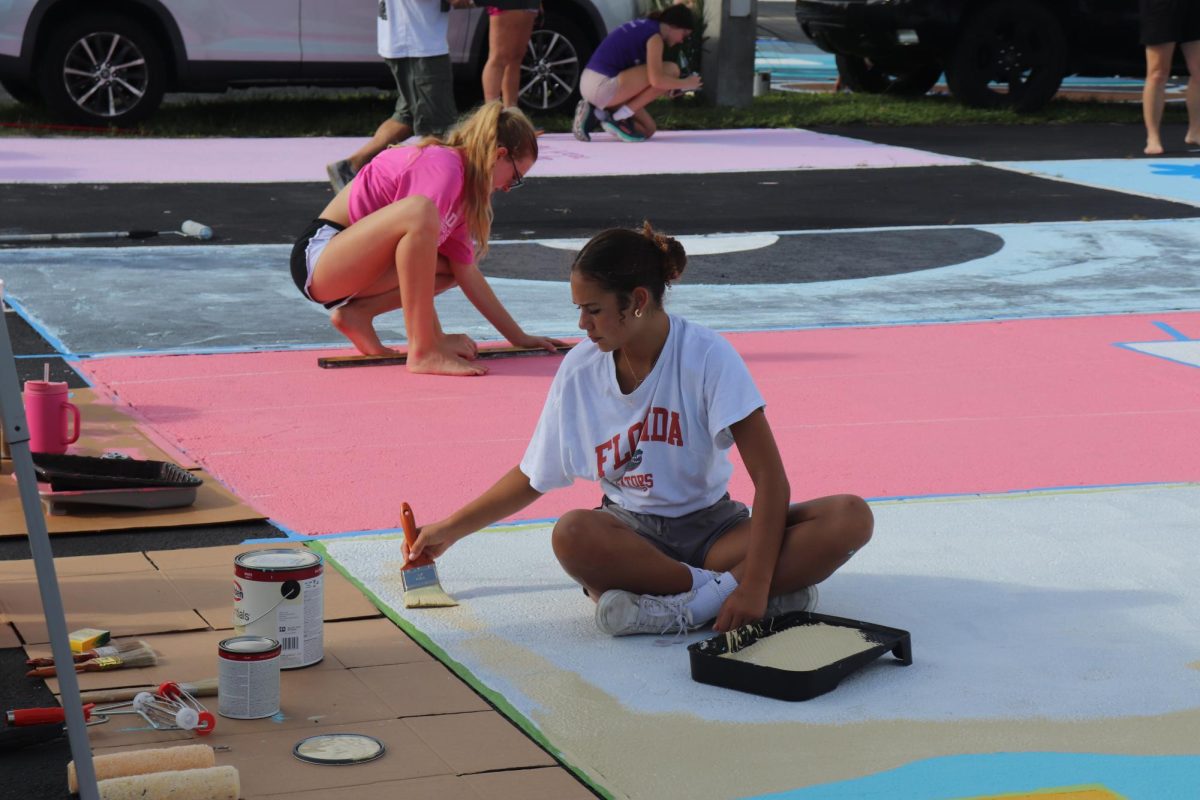Staring at her artwork displayed on the ceiling of her beloved classrooms, senior Eve Looby said she feels a renewed sense of pride, knowing her school legacy is secured. She painted two ceiling tiles — one in the digital art classroom and another in the biology lab, marking classes she considers significant to her high school career.
“I took classes in [digital art teacher James Finch’s] room since middle school, and it was such a fun time,” she said. “After taking digital art all the way through AP, I wanted to have a living memory and one last piece of artwork stay in the room forever. I also painted one in biology [in May] after taking the AP exam.”
Last school year, students weren’t allowed to paint the ceiling tiles. However, Principal Buster Clark said he sees no problem with students expressing themselves by painting school tiles.
“They could add authenticity to the room, especially if it’s very expressive of the environment or the teacher or the class itself,” he said. “I always think that the less we can make school feel institutionalized, the better. The more color, the more vibrance, the more things that it can do to stimulate our thinking and our creativity are all positive things. Nothing is worse than sitting in a room with four walls and everything’s white, so to soften the environment a bit just makes for a better learning environment.”
Senior and digital art student Scarlett Edammudalige said the ability to spread her art as a student is important beyond “a fun painting project.”
“Painting ceiling tiles fosters school pride since students want to be able to participate more on the campus that they go to every single day,” she said. “It’s really nice to leave my mark on such an important classroom to me. I love Mr. Finch and I love his classes.”
While students are now allowed to paint ceiling tiles, they must go through a brief, unofficial vetting process.
“It is only OK under the teacher’s direction,” Clark said. “If a teacher would like to have some ceiling tiles painted in their classroom, they just have to run it through [Assistant Principal Sarah] Perry and then go from there, and we have got to make sure we’re using the right type of paint and that whatever is on it is appropriate, but I’m all about student expression. Whether we can have some new murals or paint ceiling tiles, I’m all for brightening up the space the best we can.”
As an end-of-the-year project, biology teacher Deanna Engler said she encourages her AP students to paint her ceiling tiles to “put a piece of their personality” into the classroom.
“My kids are great,” she said. “They clean up after themselves, and after I told them [the artwork] has to be bio-themed, they came up with ideas that are so creative and they love [the process]. They spend days planning what they want to put on their tile, then they come and visit me, and after they leave, the first thing they want to do is come and see their tile. It’s something that’s so meaningful to them after they graduate.”
Clark said a potential reason they weren’t allowed previously was that some administrators thought it drew attention off class instruction, but Edammudalige said she struggles to understand how they were ever considered distracting.
“Nobody is sitting in class and staring up at the ceiling and getting distracted,” Edammudalige said. “The painted ceiling just gives more life to the classroom, and honestly it’s really nice to see how the students before you have expressed themselves.”
Looby said last year’s administration had a desired look for the school and those standards failed to include student artwork in classrooms.
“Admin wanted the classrooms to be more uniform,” Looby said. “And getting the ceiling tiles down is a little dangerous, so I can see why they might not want students doing that. But that’s an easy workaround and there’s faculty able to help with that, so it really should be OK.”
Counter to the “old school mindset,” Clark said making school “very regimented, very organized, and very linear” is not the ideal learning environment for students.
“I just don’t know that learning is very linear,” Clark said. “There’s more nuance than that. I’ve talked a lot about different learning styles and different learning environments and all those types of things. The more we can do to tend to those things, the more equitable we make the learning process. I’m always looking for a reason to say ‘yes’ to a teacher or to a student who is coming and asking about something that is either for them or for the greater good. My answer will never just be ‘no’ because it’s how it’s been done in the past. I’m always going to be looking through the lens of, ‘is there a path to ‘yes’?'”
While Clark gave his ‘yes’ to painting the ceiling tiles, he said financial issues likely added to the concern of last year’s administrators.
There’s a chance that if we were in a classroom and we painted 15 of the ceiling tiles, and then that teacher left, and the next teacher, given they may not want those tiles painted, may decide to switch them out,” Clark said. “And the cost of replacement is not a great reason to say ‘no’. Sometimes financial reasons are a reason to say yes or no, but giving someone that opportunity to leave a mark on their school would be important to them.”
Edammudalige said last year’s administrators gave a blank excuse since the benefits of the artwork outweigh the drawbacks.
“If a new teacher was to move into a classroom, they wouldn’t necessarily have to remove the tiles, because they’re not bothering anybody, and the students of the new teacher could always add new tiles,” Edammudalige said. “Regardless, it’s not a waste of materials, because it’s an experience, and at the end of the day, it’s there for past, present and future students. No one wants to feel like they’re in a hospital with bright lighting and white walls, so [with the painted tiles] it makes school more colorful and fun.”



![Sophomore Isabelle Gaudry walks through the metal detector, monitored by School Resource Officer Valerie Butler, on Aug. 13. “I think [the students have] been adjusting really well," Butler said. "We've had no issues, no snafus. Everything's been running smoothly, and we've been getting kids to class on time.”](https://westshoreroar.com/wp-content/uploads/2025/08/IMG_9979-1200x800.jpg)



































